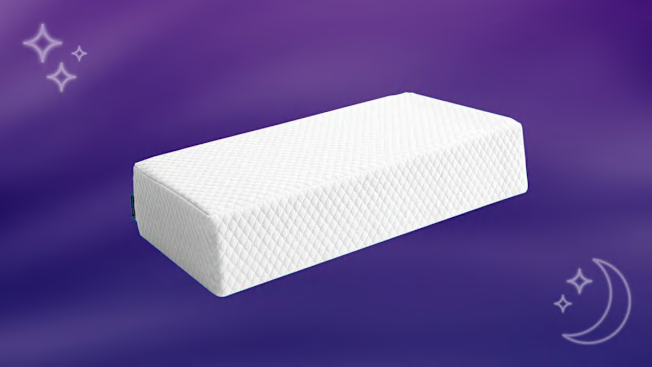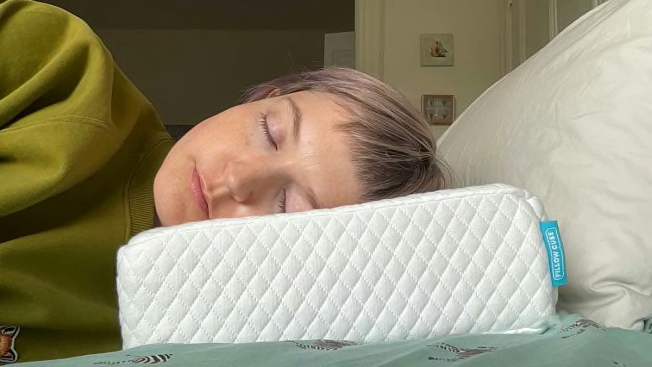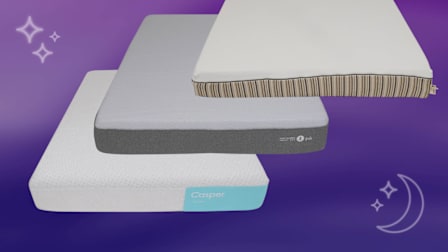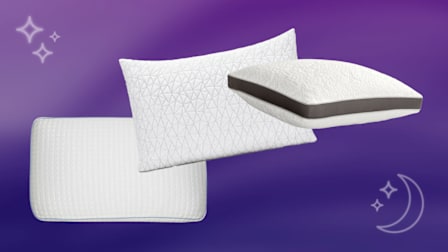Is the Pillow Cube the Secret to a Good Night’s Sleep?
We compared the popular cube-shaped pillow with the Coop, our highest-rated pillow for side sleepers
When you shop through retailer links on our site, we may earn affiliate commissions. 100% of the fees we collect are used to support our nonprofit mission. Learn more.

Around the time I turned 30, I started experiencing something I’d never given much thought to: neck pain. Despite regular exercise and being otherwise generally healthy, I’d occasionally get what my parents would refer to as a stiff, uncomfortable “crick” in my neck that inhibited easy movement and sometimes caused pain that lasted until the following day.
This new, uncomfortable sensation was a reminder that I was no longer a 23-year-old who could sleep on a friend’s carpet with a throw pillow and wake up fine. It was also a wake-up call: I needed to upgrade my bedding situation.
How the Pillow Cube Could Help Side Sleepers
The Pillow Cube is designed to align your head, neck, and spine so that when lying on your side, your neck doesn’t bend at an awkward, uncomfortable angle, either down toward the mattress or, if a pillow is too lofty or a mattress too soft, up toward the ceiling.
“If you imagine yourself lying down on your back on a mattress, you really don’t need that much support,” says Rebecca Robbins, PhD, a sleep scientist at the Brigham and Women’s Hospital in Boston. But if you’re a side sleeper, “imagine yourself on a mattress and think about the space between your shoulder and your head. That is several inches for anyone,” she says. “If you don’t have enough support, it’s going to jeopardize your shoulder and potentially create a risk for shoulder injuries."

Photo: Angela Lashbrook/Consumer Reports Photo: Angela Lashbrook/Consumer Reports
For this reason steadfast side sleepers, depending on their height, the width of their shoulders, and the softness of their mattress, may benefit from a taller, loftier pillow that prevents their neck from bending at odd angles in the night.
“Side sleepers are going to want thicker pillows in general because they want to fill in that gap between the mattress and their head,” says Rafael Pelayo, MD, a clinical professor in the Sleep Medicine Division at Stanford University in California and the author of “How to Sleep: The New Science-Based Solutions for Sleeping Through the Night” (Artisan, 2020). Cuboid-shaped pillows “fill in that space. That’s the idea behind that."
CR's Mattress Ratings & Buying Guide
Find the best mattresses for side sleepers.
Most side sleepers don’t stay completely still throughout the night but rather move a bit, from side to side or even (as in my case) into completely different positions. If you didn’t move at least some, you’d get bed sores, Pelayo says.
Robbins says that patients are convinced they keep still through the night, but “when we pull them into the laboratory and show them how many times they move, their jaws drop to the ground, like, "I had no idea. This is crazy!" Robbins says that we all move during our sleep in and out of one of several sleeper positions—back, stomach, or side. Nevertheless, we spend the majority of our night in one of those three positions.
The Pillow Cube vs. the Coop Pillow
The Coop Pillow
Movers like me might find that solid foam pillows—foam pillows that contain one solid slab of foam—while offering excellent support for side sleepers, “are tough to adjust to your shifting,” says Chris Regan, who oversees mattress and pillow testing at CR. “I recommend pillows that contain shredded foam or feathers (or mixes) for people who shift around a lot—but be careful because some of these pillow types can lack enough fill to support side sleepers with broad shoulders. Pillows with a looser style of filling can adapt better to different sleeping positions than solid ones.”
The Coop, which is made of a blend of cross-cut memory foam and microfiber, is such a pillow. I’m not being hyperbolic when I say that with the Coop, I had one of my most comfortable nights in recent memory. It’s relatively firm and even a bit heavy, unlike the Pillow Cube, which has a more solid, springy texture.
When I fell asleep on my side, the Coop supported my head and kept it aligned with my spine; when I shifted to my back, it shifted a bit with me, thus preventing my head from being bent forward, toward my chest. It’s also adjustable, so if the loft isn’t perfect, you can take out some filling to make it thinner, or add some, which the company includes with your pillow order, to make it taller. The company also says that those who reliably switch positions can stuff one side of the pillow higher than the other for maximum comfort. Michael Breus, PhD, a clinical psychologist also known as the Sleep Doctor, says adjustability is one of the most important features of pillows for side sleepers (along with width because side sleepers can fall off the edge of the pillow when flipping from side to side).
Coop advises throwing the pillow in the dryer with a dryer sheet for 10 to 15 minutes or letting it fluff up for 24 hours. I don’t have a dryer, so I let it fluff up for a day before using it. Ginger says the chemical odor her Coop emitted was so strong that it took 48 hours of off-gassing in her guest room before she could sleep on it. (The company advises customers bothered by the smell to toss their pillow in the dryer for an hour or two with a dryer sheet to get rid of the memory foam stink.) But “once I got past the smell and figured out the filling, I found this pillow to be close to perfection,” she says. “This pillow is a game-changer, and I will be purchasing one for my side-sleeper husband.” Be sure to thoroughly fluff before using and quickly fluff it every morning to keep the pillow in top form.
The Pillow Cube
Ginger and I had less success with the memory foam-based Pillow Cube. It comes in three sizes, so I bought the smallest, for people shorter than 5 feet 3 inches tall, and Ginger got the standard size for 5-foot-4-inch to 6-foot-3-inch people. The pillow kept my head and spine aligned when I lay on my side atop my medium-firm Casper mattress, but when I flipped onto my back, my head was pushed slightly forward, with the 90-degree edge digging uncomfortably into my neck. Were I to move around less, it’s possible I’d like the Pillow Cube more, but as it stands, I’m simply too mobile of a sleeper to use it.
Ginger, on the other hand, found that the standard size was too tall for her shoulders, which made for awkward positioning. She doesn’t necessarily place the blame on the pillow, but rather her mattress, an almost 10-year-old Sealy Activsleep Ortho Posture Mattress pillow top. “Out of curiosity, I brought it to my office, where I have a leather sleeper sofa that I use as an extra bed for guests,” she says. The sofa is only a year or two old, and the cushions are firm, so when she lay down on it with the Pillow Cube beneath her head, “I was able to position my head and neck in a way that I envisioned immediately. I had that aha moment—oh, this is how it’s supposed to work! So I suspect this pillow may be more effective when used in combination with a firmer mattress.”
Should You Get the Pillow Cube?
If you’re a regular side sleeper with a firmer mattress and struggle with neck pain, you might want to consider the Pillow Cube, which offers refunds within 60 days of initial purchase. You may also have success with another solid foam pillow like the Comfort Revolution, which rates highly in our tests.
A Pillow Cube customer service representative told Consumer Reports that “the Pillow Cube works best for side sleepers, but we do have many back sleepers who love the thin and standard height of the Side Sleeper Pro! These pillows are just tall enough to support them while they sleep on their side, but also short enough to allow comfortable sleep in case they may roll on their backs.” Clearly, this isn’t the case for me—at 5 feet tall, I’m already using the smallest size available and the pillow is a little bit too big for me to sleep on my back—but for average to tall folks, or those with softer mattresses that they sink into, this may be a reasonable solution if you want to try out the Pillow Cube.
Others who change position through the night, however, may find greater success with an adjustable pillow that contains looser filling but is still lofty yet firm, like the Coop (which has a 100-day return policy). I’m looking forward to a lifetime of more comfortable sleep now that I’ve found the Coop.
































